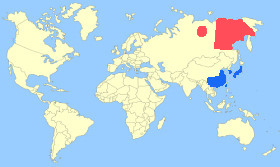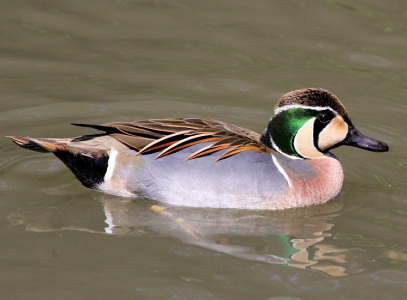Appearance:
Male - The male Baikal Teal has a distinctive head with a dark crown bordered by a white stripe, creamy buff face, with a green iridescent patch on the sides of the head, black chin, and a thin black stripe from the chin to the eye. The breast is light brown or pinkish with dark spots, bluish-grey flanks, whitish undersides, black elongated scapulars, dark grey beak and yellow-grey legs.
Female - The female is mainly brown with a dark brown crown, a distinctive white spot at the base of the beak, dark stripes from the eye to the nape, and a white throat.
Eclipse - The male in eclipse plumage is similar to the female and also has a white spot at the base of the beak but has a thin dark stripe from the chin to the eye, and a pinkish-white breast with dark spots.
 |
 |
 |
Size: - Typical Adult is 39-43cm (15-17in).
Food: - Mainly seeds and small aquatic invertebrates, rice, and soya beans.
Habitat/Range: - Pools, swampy forests, and lowland fresh waters in eastern Siberia, and wintering in south Japan, south-east China, and south Korea.

 Breeding Habitat/Resident,
Breeding Habitat/Resident,  Migration or Winter Area.
Migration or Winter Area.Breeding Season: - Late April to early July.
Eggs: - 8 to 10 (pale olive-green colour).
Notes: - The Baikal Teal is also called the Bimaculate Duck or Squawk Duck and is a dabbling duck which is slightly larger than the Common Teal. The name 'Baikal' comes from the world's deepest lake in Siberia.
Conservation status (IUCN 3.1):
Least Concern.
Classification: - Family: Anatidae,
Subfamily: Anatinae, Genus: Anas.






































